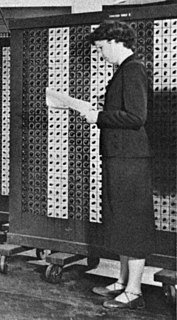Related Research Articles
Computer programming is the process of performing a particular computation, usually by designing and building an executable computer program. Programming involves tasks such as analysis, generating algorithms, profiling algorithms' accuracy and resource consumption, and the implementation of algorithms. The source code of a program is written in one or more languages that are intelligible to programmers, rather than machine code, which is directly executed by the central processing unit. The purpose of programming is to find a sequence of instructions that will automate the performance of a task on a computer, often for solving a given problem. Proficient programming thus usually requires expertise in several different subjects, including knowledge of the application domain, specialized algorithms, and formal logic.

COBOL is a compiled English-like computer programming language designed for business use. It is an imperative, procedural and, since 2002, object-oriented language. COBOL is primarily used in business, finance, and administrative systems for companies and governments. COBOL is still widely used in applications deployed on mainframe computers, such as large-scale batch and transaction processing jobs. However, due to its declining popularity and the retirement of experienced COBOL programmers, programs are being migrated to new platforms, rewritten in modern languages or replaced with software packages. Most programming in COBOL is now purely to maintain existing applications; however, many large financial institutions were still developing new systems in COBOL as late as 2006.

Grace Brewster Murray Hopper was an American computer scientist and United States Navy rear admiral. One of the first programmers of the Harvard Mark I computer, she was a pioneer of computer programming who invented one of the first linkers. Hopper was the first to devise the theory of machine-independent programming languages, and the FLOW-MATIC programming language she created using this theory was later extended to create COBOL, an early high-level programming language still in use today.
PL/I is a procedural, imperative computer programming language developed and published by IBM. It is designed for scientific, engineering, business and system programming. It has been used by academic, commercial and industrial organizations since it was introduced in the 1960s, and is still used.

Paul Graham is an English-born American computer scientist, essayist, entrepreneur, venture capitalist, and author. He is best known for his work on the programming language Lisp, his former startup Viaweb, cofounding the influential startup accelerator and seed capital firm Y Combinator, his blog, and Hacker News. He is the author of several computer programming books, including: On Lisp, ANSI Common Lisp, and Hackers & Painters. Technology journalist Steven Levy has described Graham as a "hacker philosopher".
CODASYL, the Conference/Committee on Data Systems Languages, was a consortium formed in 1959 to guide the development of a standard programming language that could be used on many computers. This effort led to the development of the programming language COBOL, the CODASYL Data Model, and other technical standards.
TOPS-10 System is a discontinued operating system from Digital Equipment Corporation (DEC) for the PDP-10 mainframe computer family. Launched in 1967, TOPS-10 evolved from the earlier "Monitor" software for the PDP-6 and PDP-10 computers; this was renamed to TOPS-10 in 1970.
DIBOL or Digital's Business Oriented Language is a general-purpose, procedural, imperative programming language, designed for use in Management Information Systems (MIS) software development.
VisualAge was a family of computer integrated development environments from IBM, which supported multiple programming languages. VisualAge was first released in October 1993 and was discontinued on April 30, 2007. It had its web page removed in September 2011. VisualAge was also marketed as VisualAge Smalltalk, and in 2005, Instantiations, Inc. acquired the worldwide rights to this product. IBM has stated that XL C/C++ is the followup product to VisualAge.

The history of programming languages spans from documentation of early mechanical computers to modern tools for software development. Early programming languages were highly specialized, relying on mathematical notation and similarly obscure syntax. Throughout the 20th century, research in compiler theory led to the creation of high-level programming languages, which use a more accessible syntax to communicate instructions.
The Burroughs B2500 through Burroughs B4900 was a series of mainframe computers developed and manufactured by Burroughs Corporation in Pasadena, California, United States, from 1966 to 1991. They were aimed at the business world with an instruction set optimized for the COBOL programming language. They were also known as Burroughs Medium Systems, by contrast with the Burroughs Large Systems and Burroughs Small Systems.

Frances Elizabeth Holberton was an American computer scientist who was one of the six original programmers of the first general-purpose electronic digital computer, ENIAC. The other five ENIAC programmers were Jean Bartik, Ruth Teitelbaum, Kathleen Antonelli, Marlyn Meltzer, and Frances Spence.
ISO/IEC JTC 1/SC 22 Programming languages, their environments and system software interfaces is a standardization subcommittee of the Joint Technical Committee ISO/IEC JTC 1 of the International Organization for Standardization (ISO) and the International Electrotechnical Commission (IEC) that develops and facilitates standards within the fields of programming languages, their environments and system software interfaces. ISO/IEC JTC 1/SC 22 is also sometimes referred to as the "portability subcommittee". The international secretariat of ISO/IEC JTC 1/SC 22 is the American National Standards Institute (ANSI), located in the United States.
Micro Focus International plc is a British multinational software and information technology business based in Newbury, Berkshire, England. The firm provides software and consultancy. The company is listed on the London Stock Exchange and is a constituent of the FTSE 250 Index.
An indexed file is a computer file with an index that allows easy random access to any record given its file key.
WATBOL is a teaching compiler for the COBOL programming language developed in 1969 at the University of Waterloo. The compiler was a companion product, built under the design philosophy, of Waterloo’s earlier, widely used WATFOR teaching compiler. Since programs written by undergraduate students were unlikely to be run more than a few times, after they were successfully written and debugged, the efficiency of the program, once compiled was of secondary importance, compared with giving simpler, clearer error messages, and in simplifying the steps for the student to compile the program. At that time executing a program through the use of commercial compiler was a three-step process. First the Fortran, or COBOL, had to be compiled into assembly language, then the assembly language had to be assembled into binary code; finally the compiled and assembled code had to be linked with previously written libraries of subroutines. WATFOR and WATBOL allowed simple programs to be compiled, linked, and executed in a single step.
The Integrated Language Environment (ILE) is a programming model developed by IBM for their AS/400 line of computers and remains an important part of the IBM i programming environment.
Albert Eugene Smith (1907-1973) was a computing pioneer who worked for the U.S. Navy following World War II. He founded the Digital Computer Newsletter published by the Navy from 1949 through 1968. Smith also participated in the development of the COBOL programming language.
Mary K. Hawes was a computer scientist who identified the need for a common business language in accounting, which led to the development of COBOL. COBOL is short for Common Business Oriented Language. It was written to resemble ordinary English. For this new language, they wish it can be run on different brands of computers and perform some advanced accounting calculation such as payroll calculation. She proposed this new language in March 1959, when she was working as a senior product planning analyst for the Electro Data Division of Burroughs Corporation. She approached Grace Hopper with the proposal, who suggested that they ask the U.S. Department of Defense (DOD) for funding. Charles Philips, an employee at the DOD, agreed and in May 1959 approximately 40 representatives of computer users and computer manufacturers met and formed the Short Range Committee of the Conference on Data Systems Languages (CODASYL).
References
- 1 2 Mitseas, Catherine (26 November 1999). "New language speaks up to help solve an old problem". The Business Journal. Archived from the original on 5 March 2001. Retrieved 13 April 2016.
- ↑ Mikes, Sam (26 March 2001). "I have seen the future, and it is COBOL?". IT WORLD. IDG Enterprise. Retrieved 26 March 2001.